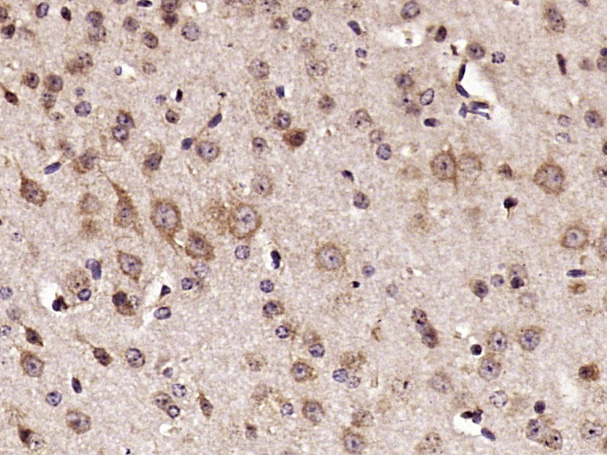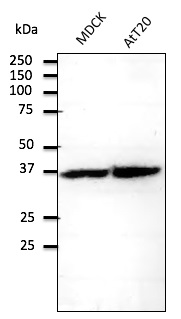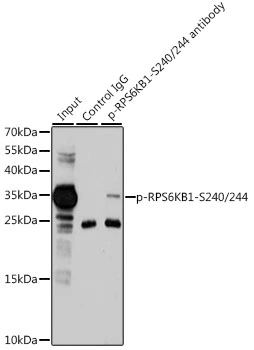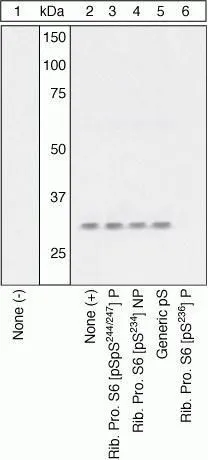RPS6 antibody
GTX113542
ApplicationsImmunoFluorescence, Western Blot, ImmunoCytoChemistry, ImmunoHistoChemistry, ImmunoHistoChemistry Paraffin
Product group Antibodies
ReactivityHuman, Mouse, Zebra Fish
TargetRPS6
Overview
- SupplierGeneTex
- Product NameRPS6 antibody
- Delivery Days Customer9
- Application Supplier NoteWB: 1:500-1:3000. ICC/IF: 1:100-1:1000. IHC-P: 1:100-1:1000. *Optimal dilutions/concentrations should be determined by the researcher.Not tested in other applications.
- ApplicationsImmunoFluorescence, Western Blot, ImmunoCytoChemistry, ImmunoHistoChemistry, ImmunoHistoChemistry Paraffin
- CertificationResearch Use Only
- ClonalityPolyclonal
- Concentration0.55 mg/ml
- ConjugateUnconjugated
- Gene ID6194
- Target nameRPS6
- Target descriptionribosomal protein S6
- Target synonymsS6, eS6, small ribosomal subunit protein eS6, 40S ribosomal protein S6, phosphoprotein NP33
- HostRabbit
- IsotypeIgG
- Protein IDP62753
- Protein NameSmall ribosomal subunit protein eS6
- Scientific DescriptionRibosomes, the organelles that catalyze protein synthesis, consist of a small 40S subunit and a large 60S subunit. Together these subunits are composed of 4 RNA species and approximately 80 structurally distinct proteins. This gene encodes a cytoplasmic ribosomal protein that is a component of the 40S subunit. The protein belongs to the S6E family of ribosomal proteins. It is the major substrate of protein kinases in the ribosome, with subsets of five C-terminal serine residues phosphorylated by different protein kinases. Phosphorylation is induced by a wide range of stimuli, including growth factors, tumor-promoting agents, and mitogens. Dephosphorylation occurs at growth arrest. The protein may contribute to the control of cell growth and proliferation through the selective translation of particular classes of mRNA. As is typical for genes encoding ribosomal proteins, there are multiple processed pseudogenes of this gene dispersed through the genome. [provided by RefSeq]
- ReactivityHuman, Mouse, Zebra Fish
- Storage Instruction-20°C or -80°C,2°C to 8°C
- UNSPSC12352203
References
- Westerich KJ, Tarbashevich K, Schick J, et al. Spatial organization and function of RNA molecules within phase-separated condensates are controlled by Dnd1. bioRxiv. 2023,:pii: 2023.07.09.548244. doi: 10.1101/2023.07.09.548244.Read this paper
- Zhao X, Sun Y, Wang Z, et al. Huntingtin exon 1 deletion does not alter the subcellular distribution of huntingtin and gene transcription in mice. Front Cell Neurosci. 2022,16:1021592. doi: 10.3389/fncel.2022.1021592Read this paper
- Kim A, Koo JH, Jin X, et al. Ablation of USP21 in skeletal muscle promotes oxidative fibre phenotype, inhibiting obesity and type 2 diabetes. J Cachexia Sarcopenia Muscle. 2021,12(6):1669-1689. doi: 10.1002/jcsm.12777Read this paper
- Yeh YH, Wang SW, Yeh YC, et al. Rhapontigenin inhibits TGF-β-mediated epithelial‑mesenchymal transition via the PI3K/AKT/mTOR pathway and is not associated with HIF-1α degradation. Oncol Rep. 2016,35(5):2887-95. doi: 10.3892/or.2016.4664Read this paper
- Chen CH, Lin DS, Cheng CW, et al. Cdc6 cooperates with c-Myc to promote genome instability and epithelial to mesenchymal transition EMT in zebrafish. Oncotarget. 2014,5(15):6300-11.Read this paper
- Goodson WH 3rd, Luciani MG, Sayeed SA, et al. Activation of the mTOR pathway by low levels of xenoestrogens in breast epithelial cells from high-risk women. Carcinogenesis. 2011,32(11):1724-33. doi: 10.1093/carcin/bgr196Read this paper





